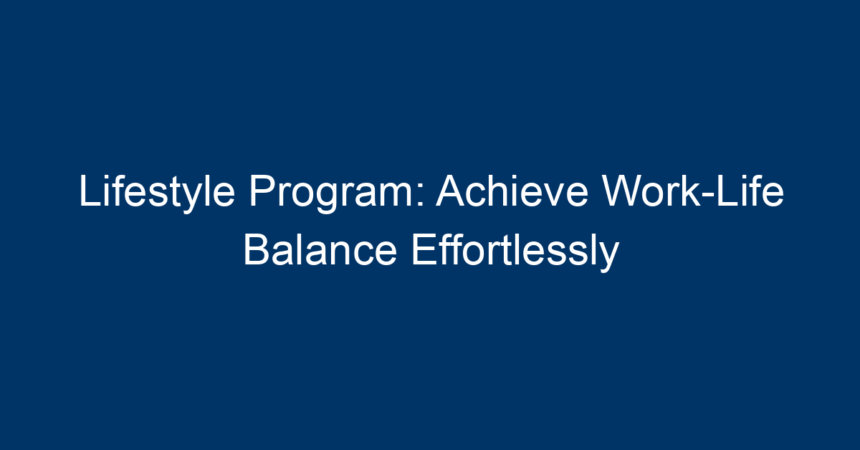In today’s fast-paced world, achieving a harmonious work-life balance can often seem like an elusive dream. Juggling personal responsibilities, demanding jobs, and social commitments is no easy feat. However, with the right lifestyle program, you can transform your day-to-day life, paving the way for a more fulfilling and balanced existence. This article will guide you through the principles of a successful lifestyle program, tips for implementation, and actionable insights to help you attain that coveted equilibrium.
Understanding the Concept of a Lifestyle Program
What is a Lifestyle Program?
At its core, a lifestyle program is a structured approach designed to enhance your overall well-being by integrating healthy habits into your daily routines. This program encompasses various aspects of life, including physical health, mental well-being, relationships, and professional fulfillment.
Why a Lifestyle Program is Crucial
In a world filled with distractions and demands, a lifestyle program serves as your roadmap, helping you prioritize your time effectively. It empowers individuals to reclaim control over their schedules while promoting greater satisfaction both at work and home.
The Pillars of a Successful Lifestyle Program
To create an effective lifestyle program, consider the following essential pillars:
1. Time Management
Importance: Effective time management is crucial for accomplishing tasks without feeling overwhelmed.
Tips:
- Set Clear Goals: Define both short-term and long-term objectives.
- Prioritize Tasks: Use techniques like the Eisenhower Matrix to identify what’s urgent versus important.
- Limit Distractions: Identify and minimize potential distractions in your environment.
2. Health and Wellness
Importance: Your physical health directly impacts your ability to manage work and life effectively.
Tips:
- Regular Exercise: Aim for at least 30 minutes of physical activity most days of the week. Activities like yoga and jogging can enhance both physical and mental health.
- Balanced Diet: Opt for a diet rich in fruits, vegetables, whole grains, and lean proteins to sustain your energy levels throughout the day.
- Sleep Hygiene: Prioritize getting 7-9 hours of quality sleep each night to enhance focus and productivity.
3. Stress Management Techniques
Importance: Chronic stress can lead to burnout, affecting both professional and personal aspects of life.
Tips:
- Mindfulness Practices: Incorporate meditation, breathing exercises, or journaling into your daily routine.
- Nature Breaks: Spend time outdoors, as nature has a calming effect and can rejuvenate your mind.
- Seek Support: Don’t hesitate to reach out for support from friends, family, or even professionals when needed.
4. Work-Life Boundaries
Importance: Establishing boundaries helps maintain a healthy separation between work and personal life.
Tips:
- Define Work Hours: Set specific times for work and stick to them, avoiding work-related tasks outside these hours.
- Create a Dedicated Space: If you work from home, designate a specific area free from distractions for work-related tasks.
- Communicate: Make your boundaries clear with colleagues and family members to ensure mutual respect.
5. Continuous Learning and Development
Importance: Investing in personal growth not only enhances your skill set but also boosts your confidence and satisfaction.
Tips:
- Enroll in Courses: Look for online courses or workshops relevant to your field or interests.
- Read Regularly: Dedicate time to read books, articles, or listen to podcasts that inspire you.
- Networking: Connect with like-minded individuals who can motivate you and share new insights.
Designing Your Personalized Lifestyle Program
Creating a customized lifestyle program requires introspection and commitment. Here’s a step-by-step guide to tailor your program effectively.
Step 1: Self-Assessment
Begin by assessing your current situation. Reflect on areas of your life that feel imbalanced, whether it’s work, relationships, or personal wellness.
Step 2: Set SMART Goals
Define Specific, Measurable, Achievable, Relevant, and Time-bound goals. For instance, instead of saying, "I want to exercise more," say, "I will jog for 30 minutes every Monday, Wednesday, and Friday for the next month."
Step 3: Create a Routine
Design a daily or weekly routine around your goals. Prioritize time for work tasks, but also include slots for relaxation and hobbies to ensure a well-rounded schedule.
Step 4: Track Your Progress
Utilizing journals or apps can help you monitor your accomplishments and challenges. Tracking allows you to celebrate small victories and adjust your program as needed.
Step 5: Stay Flexible
Life is unpredictable, and flexibility is key. Be open to revisiting your goals and adjusting your plans as circumstances change.
Overcoming Common Challenges
Implementing a lifestyle program isn’t without its hurdles. Here are common obstacles and strategies to overcome them:
Lack of Motivation
It’s easy to lose sight of your goals. Consider joining a supportive community or finding a workout buddy to keep your motivation high.
Time Constraints
If you feel there aren’t enough hours in the day, assess your schedule for time-wasters. Delegating tasks or saying no to non-essential commitments can free up valuable time.
Resistance to Change
Change is often met with resistance. Start small by integrating one habit at a time. Gradual changes are more sustainable and less intimidating.
Actionable Insights for Achieving Work-Life Balance
- Conduct Weekly Reviews: Spend time each week to evaluate what worked and what didn’t, tweaking your lifestyle program accordingly.
- Incorporate Fun Activities: Engage in hobbies or activities that recharge you, such as painting, hiking, or gardening.
- Practice Gratitude: Reflecting on what you’re grateful for can cultivate a positive mindset and improve your overall outlook on life.
- Create a ‘No’ List: Identify activities, commitments, or responsibilities that drain your energy and learn to say no.
Conclusion
In a world that often prioritizes productivity over well-being, developing a personalized lifestyle program is your pathway to achieving work-life balance effortlessly. By focusing on time management, health, stress reduction, and personal development, you empower yourself to create a fulfilling life that harmonizes work and leisure.
Take the first step today—your future self will thank you. Embrace the journey towards a balanced lifestyle, and watch as your productivity and happiness flourish hand-in-hand.
By implementing the strategies discussed in this article, you can create a lifestyle program that not only promotes work-life balance but also enhances your overall quality of life. Start small, stay consistent, and remember that balance is not a destination but a journey.




